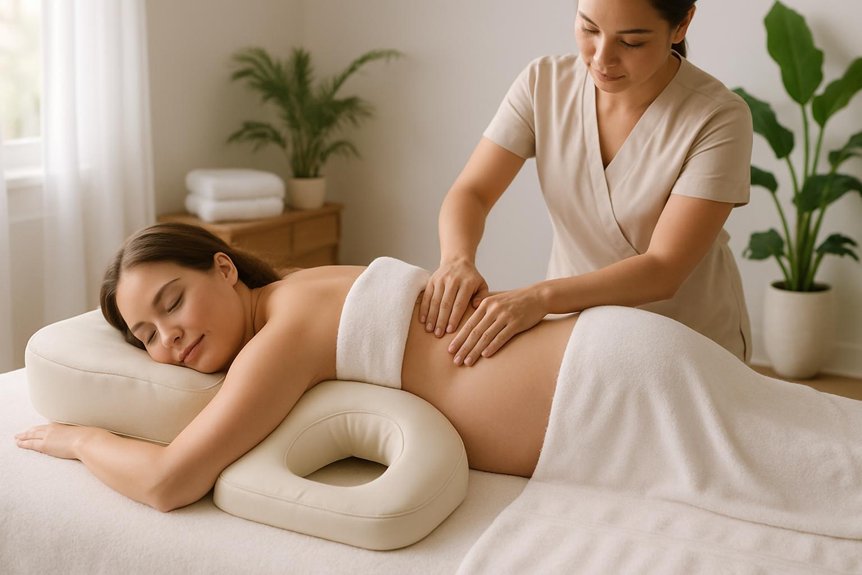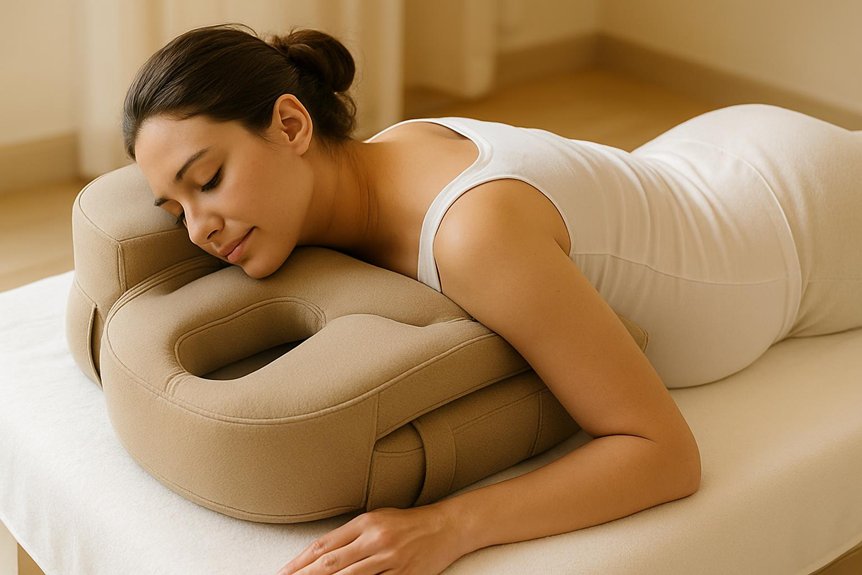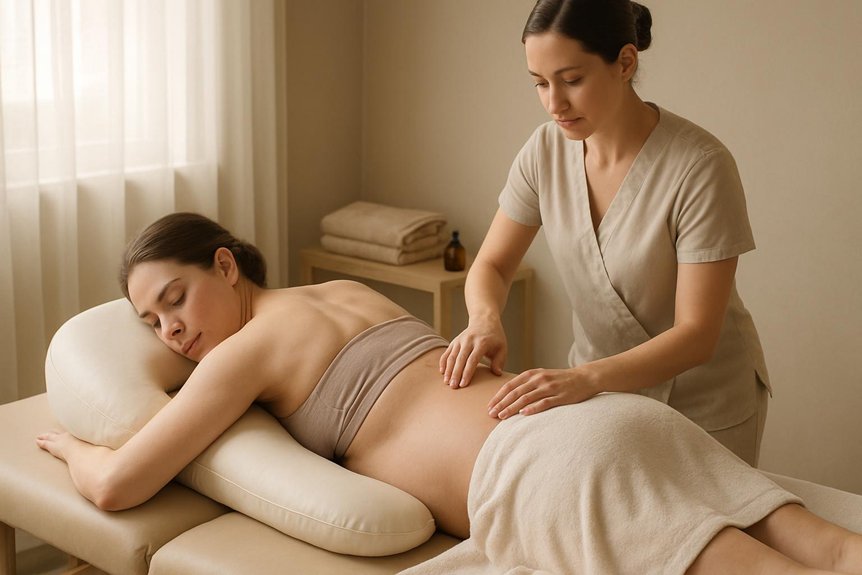Pregnancy massage pillows, when constructed from medical-grade, hypoallergenic, and antimicrobial materials, are considered safe and effective for supporting ergonomic positioning during prenatal therapy. Properly contoured designs help maintain maternal comfort, reduce musculoskeletal strain, and optimize circulation, especially when used with evidence-based positioning protocols like the side-lying method. Therapists emphasize individualized assessment and patient feedback to maximize safety. Additional information covers essential safety features, recommended practices, and how these pillows enhance both comfort and security in clinical care.
Understanding Pregnancy Massage Pillows

A pregnancy massage pillow is a specialised support device designed to accommodate the anatomical changes experienced during pregnancy, particularly in the abdomen and pelvic regions. This pillow typically features a contoured cut-out or recess, allowing the expectant mother to rest comfortably in a prone or side-lying position without exerting pressure on the uterus.
Clinical studies indicate that ideal spinal alignment and pelvic support reduce musculoskeletal strain, enhance maternal relaxation, and promote the safe delivery of therapeutic massage.
At Spa & Massage, therapists select pillows constructed from hypoallergenic, medical-grade materials to guarantee both comfort and hygiene. The patient-centered approach focuses on individualised adjustments, ensuring each client’s unique body shape and gestational stage are considered.
This attention to detail fosters a nurturing, secure experience during every session. Massage therapists sometimes integrate techniques such as reflexology to further enhance relaxation and support overall wellbeing during pregnancy.
How Pregnancy Massage Pillows Support Expecting Mothers
Pregnancy massage pillows are designed to alleviate pressure points by providing targeted support to the abdomen, hips, and lower back, thereby minimizing discomfort during treatment.
In clinical practice at Spa & Massage, these specialized cushions enhance maternal comfort and safety by facilitating ideal positioning and reducing musculoskeletal strain.
Moreover, appropriate pillow use promotes relaxation and rest, supporting overall maternal well-being throughout the massage experience.
Alleviating Pressure Points
While gestational changes place increased biomechanical stress on the body, specialised support systems such as pregnancy massage pillows play a critical role in alleviating pressure points during therapeutic sessions. These pillows redistribute body weight, minimising compression on sensitive areas such as the sacrum, hips, and shoulders.
By contouring to the unique curves of the pregnant form, they decrease the risk of nerve impingement and localised discomfort, which is especially relevant as maternal musculoskeletal adaptations progress.
At Spa & Massage, therapists utilise these pillows to optimise maternal positioning, ensuring even pressure distribution and reducing strain on joints and ligaments. This approach supports healthy circulation and promotes relaxation, allowing expecting mothers to experience therapeutic touch without exacerbating common pregnancy discomforts.
Such personalised care enhances the overall sense of safety and well-being.
Enhancing Comfort and Safety
Building upon the targeted alleviation of pressure points, proper utilisation of pregnancy massage pillows further enhances maternal comfort and safety throughout each session. These specialised supports are designed to accommodate the gravid abdomen, reducing musculoskeletal strain and allowing for ideal alignment of the spine and pelvis.
At Spa & Massage, therapists assess individual anatomical changes, adjusting pillow placement to ensure stable, ergonomic positioning—minimising the risk of nerve compression or vascular compromise. This patient-centred approach fosters a sense of security, allowing expectant mothers to relax without fear of undue pressure on sensitive regions.
Clinical evidence underscores the importance of adaptable positioning aids in promoting circulation and reducing discomfort. Through thoughtful application, pregnancy massage pillows provide a nurturing foundation, supporting both physical wellbeing and emotional reassurance during a transformative time.
Promoting Relaxation and Rest
The use of specialised massage pillows during prenatal treatments creates an ideal environment for rest and neuromuscular relaxation. By supporting the natural contours of the pregnant body, these pillows reduce musculoskeletal tension and facilitate perfect alignment.
Clinical studies suggest that ergonomic positioning decreases sympathetic nervous system activity, leading to lower stress hormones and deeper states of relaxation. At Spa & Massage, therapists integrate pregnancy pillows to enhance parasympathetic activation, encouraging restorative rest.
This approach not only relieves physical discomfort but also fosters emotional tranquillity, which is essential for maternal well-being. Clients frequently report improved sleep quality and a heightened sense of calm following sessions.
Ultimately, pregnancy massage pillows are instrumental in nurturing both body and mind, promoting holistic comfort for expecting mothers.
Safety Features to Look for in Pregnancy Massage Pillows

An essential consideration when selecting pregnancy massage pillows is the presence of specific safety features designed to support maternal and fetal well-being. Clinically, appropriate pillows should offer adjustable support, ensuring proper spinal alignment and reducing abdominal pressure.
Hypoallergenic, medical-grade materials are preferred to minimise irritation and allergic reactions. Non-slip surfaces enhance stability, decreasing the risk of accidental shifting during treatment.
At Spa & Massage, therapists favour pillows with contoured cutouts that accommodate the gravid abdomen and sensitive breast tissue, promoting comfort while alleviating vascular compression.
Easy-to-clean, antimicrobial covers reduce infection risk—a feature particularly valued in our clinics.
For patient-centred care, therapists also assess firmness and adaptability, tailoring support to each client’s unique body changes throughout pregnancy, therefore ensuring a nurturing and safe massage experience.
Recommended Positions for Prenatal Massage
Current clinical guidelines emphasize the side-lying position as the safest and most comfortable posture for prenatal massage, particularly in the second and third trimesters.
This position, combined with strategically placed support pillows, helps maintain spinal alignment and reduces pressure on the abdomen and lower back.
At Spa & Massage, therapists utilize specialized pregnancy pillows to optimize maternal comfort and promote effective relaxation during each session.
Side-Lying Position Benefits
While undergoing prenatal massage, adopting the side-lying position offers significant physiological and comfort advantages for pregnant clients. Clinically, this position reduces pressure on the inferior vena cava, promoting ideal maternal circulation and fetal oxygenation.
It alleviates musculoskeletal strain, particularly in the lumbar and pelvic regions, accommodating natural anatomical changes during pregnancy. The side-lying posture enables therapists, such as those at Spa & Massage, to access areas prone to tension—such as the lower back and hips—while maintaining the client’s safety and dignity.
Many clients report a sense of security and relaxation, as the position naturally supports the abdomen and allows gentle communication between therapist and client. This approach reflects Spa & Massage’s commitment to personalised, nurturing care tailored to each stage of pregnancy.
Pillows for Support
How do strategically placed pillows enhance safety and comfort during prenatal massage sessions? Clinical evidence underscores that tailored pillow support minimizes musculoskeletal strain and optimizes maternal-fetal circulation.
During pregnancy massage at Spa & Massage, therapists position pillows beneath the abdomen, between the knees, and along the back to maintain spinal alignment and relieve pelvic and lumbar pressure. This approach reduces the risk of venous compression and facilitates deep relaxation, fostering an intimate sense of care.
Side-lying with pillow support is strongly recommended, as it accommodates anatomical changes while safeguarding both mother and baby. By adjusting pillow placement according to individual needs, therapists create a nurturing environment that prioritizes safety, comfort, and emotional connection—hallmarks of the patient-centered philosophy at Spa & Massage clinics.
Benefits of Using Pregnancy Massage Pillows in Our Clinics
Pregnancy massage pillows provide essential ergonomic support and safety enhancements for expectant mothers during therapeutic sessions at Spa & Massage clinics. These specialised cushions are designed to accommodate anatomical changes throughout pregnancy, allowing clients to rest comfortably in side-lying or semi-reclined positions.
This ideal positioning reduces pressure on the abdomen, pelvis, and lower back, minimising strain on musculoskeletal structures and promoting relaxation. Spa & Massage therapists employ pregnancy pillows to facilitate effective myofascial release and lymphatic drainage, tailored to the unique needs of each trimester.
Enhanced comfort and stability foster a sense of security and trust, enabling deeper therapeutic outcomes. By integrating these tools, Spa & Massage makes certain that both maternal wellbeing and fetal safety are prioritised, delivering a nurturing environment for every expectant client.
Possible Risks and Precautions During Prenatal Massage

Although prenatal massage is widely regarded as beneficial for maternal health, it is not without certain risks that must be carefully managed. Clinical evidence indicates that improper positioning, excessive pressure, or inappropriate techniques can contribute to discomfort, musculoskeletal strain, or circulatory complications such as deep vein thrombosis.
In addition, particular attention must be paid to areas like the lower back and abdomen, where sensitivity increases throughout pregnancy. Contraindications such as preeclampsia, high-risk pregnancies, or placental complications require consultation with a healthcare provider before proceeding.
At Spa & Massage, the safety of each client is paramount; therapists assess medical history, trimester, and current symptoms before treatment. This patient-centered approach minimizes risk, ensuring that massage supports both physical comfort and emotional wellbeing during this important life stage.
Our Therapists’ Approach to Ensuring Comfort and Safety
Prioritising maternal wellbeing, Spa & Massage therapists implement evidence-based protocols to optimise both comfort and safety during prenatal massage sessions. Each therapist conducts a comprehensive assessment, considering gestational age, maternal health, and individual preferences.
Specialised pregnancy massage pillows are utilised to facilitate optimal spinal alignment and relieve pressure on the abdomen and pelvis. Therapists adjust positioning, typically offering side-lying or semi-reclined alternatives, to minimise strain and enhance relaxation.
Continuous monitoring of client feedback allows for real-time adjustments, ensuring that the client’s comfort and circulation are maintained throughout. Only hypoallergenic oils and gentle techniques are employed, tailored to the unique physiological changes of pregnancy.
At Spa & Massage, the therapeutic environment is created to foster trust, intimacy, and confidence throughout this significant stage of life.
Tips for a Relaxing and Secure Pregnancy Massage Experience
Following Spa & Massage’s rigorous protocols for maternal safety, several strategies can further enhance both relaxation and security during prenatal massage sessions. Positioning is paramount; therapists utilize side-lying or semi-reclined postures with supportive cushions to alleviate pressure on the abdomen and lower back.
Communication remains central—clients are encouraged to express any discomfort or sensitivity, ensuring continuous adjustment of techniques. The use of hypoallergenic, unscented oils minimizes the risk of dermal reactions, a standard in Spa & Massage’s approach.
Gentle, rhythmic strokes are prioritized to promote circulation and reduce edema without overstimulating sensitive tissues. Hydration is recommended pre- and post-session.
Ultimately, tailoring each treatment to the individual’s trimester and physical presentation fosters both physiological well-being and a sense of intimate, nurturing care throughout pregnancy.
Conclusion
As gentle hands adjust the contoured pillows beneath an expectant mother, the clinic’s tranquil environment envelops her in safety. Evidence underscores that, when expertly applied, pregnancy massage pillows can substantially enhance maternal comfort while mitigating musculoskeletal strain. By adhering to clinical guidelines and prioritising patient-centred care, trained therapists transform each prenatal massage into a secure, restorative experience. Therefore, with proper technique and vigilance, these supportive cushions become a cornerstone in nurturing both maternal well-being and peace of mind.